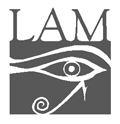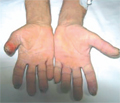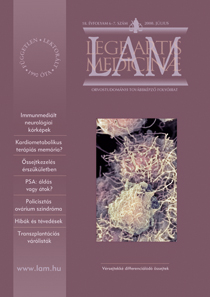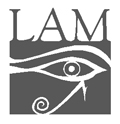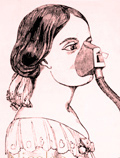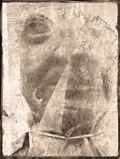The eLitMed.hu medical portal uses computer cookies for convenient operation. Detailed information can be found in the Cookie-policy.
Lege Artis Medicinae - 2008;18(06-07)
Content
[IMMUNE-MEDIATED NEUROLOGICAL DISORDERS]
[Multiple sclerosis, myasthenia gravis and chronic inflammatory neuropathies share the common feature of chronic course with potential development of disability due to the damage caused by immunological processes. Early detection and precise diagnosis is very important, because most patients respond well to proper immunomodulatory treatment. The diagnosis requires extensive knowledge of the disease and is based on the clinical symptoms recognised by the GP, as well as on complex assessment of the results of special neurophysiological, radiological and laboratory examinations. The present paper reviews the major immune-mediated neurological disorders and discusses their targeted immunological treatment.]
[LATE EFFECTS OF TREATMENT FOR DECREASING CARDIOVASCULAR RISK “CARDIOMETABOLIC THERAPEUTIC MEMORY” - A HYPOTHESIS]
[In several randomised, controlled clinical studies conducted to decrease cardiovascular morbidity and mortality, there was long-term observational follow-up after the termination of the double-blind phase. There is evidence that the beneficial effect of the therapeutic intervention in the active study phase was maintained in the follow-up period. This phenomenon was observed both for life-style modification and for pharmacological intervention, including the use of ACE-inhibitors, statins, fibrates and intensive insulin treatment. This fact suggests the possibility that even after several years, the body “remembers” the beneficial effects of the cardiovascular risk reduction achieved years earlier. The phenomenon may be called “cardiometabolic therapeutic memory”.]
[THE EFFECTS AND SIDE-EFFECTS OF COXIBS IN THE RHEUMATOLOGICAL PRACTICE]
[The author reviews the various tools of pain control in rheumatic disorders, with special attention to the pharmacological modalities, focusing on the use of cyclo-oxygenase inhibitors (coxibs). The new pain control drugs have different side-effect profiles, and even though these are more favourable than those of the traditional drugs, not all of them meet the strict safety requirements. The new drugs that are available in Hungary have a lower gastrointestinal side effect risk than the traditional nonsteroidal anti-inflammatory drugs, still with comparable effectiveness. The non-steroidal antiinflammatory drugs - including the selective cyclo-oxygenase inhibitors - increase the risk of cardiovascular disease, though to varying extent. When choosing a drug to control pain and inflammation in the diseases of the locomotor system, the physician should balance between the effectiveness and the most common side effects (gastrointestinal, cardiovascular).]
[UNSOLVED THERAPY - COMPLEX TREATMENT OF BUERGER’S DISEASE]
[INTRODUCTION - Buerger’s disease is a nonatherosclerotic, segmental, inflammatory, progressive obliterative disease of the blood vessels that most commonly affects the small and medium-sized arteries and also the veins of the lower limb. It is strongly associated with tobacco use. CASE REPORT - A 37-year-old heavy smoker forest worker presented with severe gangrenous changes on the fingers as the upper limb manifestations of Buerger’s disease, which required acral amputation. After complex medical treatment, pharmacological sympathectomy on the left side and surgical sympathectomy on the right side, bilateral conserving necrectomy, cessation of smoking and 2 cycles of cyclophosphamid, the patient's status significantly improved, his pain diminished and, although to a limited extent, he could use both hands. CONCLUSIONS - Buerger’s disease is a disorder with unclear aethiology and is difficult to diagnose. Despite of a good prognosis, a causal treatment is not yet possible, so any antithrombotic, haemorheological, vasodilator or immunosuppressive therapy that have been reported to have beneficial effect should be considered for treatment.]
[SPONTANEOUS RUPTURE OF THE SPLEEN IN PULMONARY FIBROSIS]
[INTRODUCTION - Splenic peliosis is a pathological entity; it is only mentioned in case reports in the literature. CASE REPORT - A 61-year-old man with hypertension and diabetes mellitus presented with effort dyspnoe that was subsequently found to be due to idiopathic pulmonary fibrosis by histological examination. During steroid therapy, a spontaneous splenic rupture developed, which the patient fortunately survived. There was no need for splenectomy, but the clinical course suggested splenic peliosis. CONCLUSION - In this case, splenic rupture was associated with idiopathic pulmonary fibrosis, a constellation that has not yet been reported. Nevertheless, it was an isolated rupture, with no similar haemorrhagic lesion of other parenchymal organs. In view of the literature data, beside primary disease steroid therapy and the coexisting diabetes may also have played a role in the development of the spontaneous splenic rupture.]
1.
Clinical Neuroscience
Is there any difference in mortality rates of atrial fibrillation detected before or after ischemic stroke?2.
Clinical Neuroscience
Factors influencing the level of stigma in Parkinson’s disease in western Turkey3.
Clinical Neuroscience
Neuropathic pain and mood disorders in earthquake survivors with peripheral nerve injuries4.
Journal of Nursing Theory and Practice
[Correlations of Sarcopenia, Frailty, Falls and Social Isolation – A Literature Review in the Light of Swedish Statistics]5.
Clinical Neuroscience
[Comparison of pain intensity measurements among patients with low-back pain]1.
Clinical Neuroscience Proceedings
[A Magyar Stroke Társaság XVIII. Kongresszusa és a Magyar Neuroszonológiai Társaság XV. Konferenciája. Absztraktfüzet]2.
3.
Journal of Nursing Theory and Practice
[A selection of the entries submitted to the literary contest "Honorable mission: the joys and challenges of our profession" ]4.
Journal of Nursing Theory and Practice
[End of Life and Palliative Care of Newborns in the Nursing Context]5.
Journal of Nursing Theory and Practice
[Aspects of Occupational Health Nursing for Incurable Patients ]





